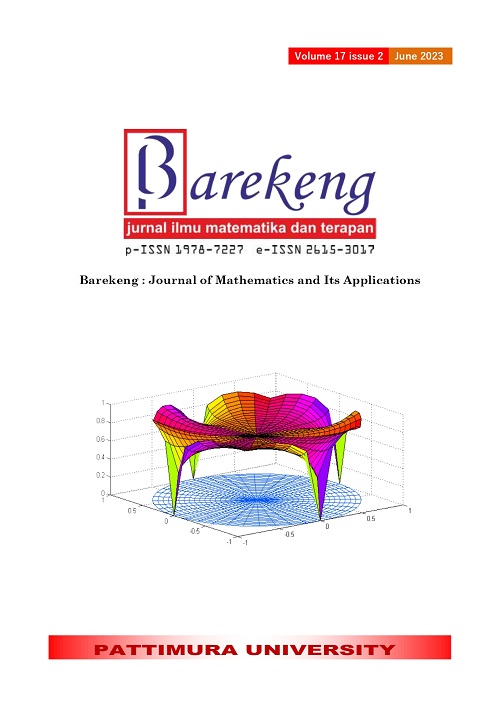DATA MINING STUDY FOR GROUPING ELEMENTARY SCHOOLS IN BOJONEGORO REGENCY BASED ON CAPACITY AND EDUCATIONAL FACILITIES
Abstract
The implementation of national education must ensure equitable distribution of educational facilities. However, based on data from the Regional Education Balance Sheet (NPD) in 2021, elementary schools in Bojonegoro District still need to meet the criteria for overall equality. It is mainly related to educational capacity and facilities. It is necessary to group elementary schools based on capacity and educational facilities to solve this problem by applying the clustering method. The research aims to conduct a comparative study of three clustering methods to get the best way to be used for clustering elementary schools in Bojonegoro Regency. This study applies three clustering methods, namely K-Means, K-Medoids, and Random Clustering, which are compared to get the best clustering method. The data used is secondary data representing educational capacity and facilities, namely the number of students, teachers, classrooms, and study groups (Rombel) from the Bojonegoro District Education Office. Obtained the resulting comparison of clustering methods with the best way falls on the K-Means method, which forms 5 clusters. It explained that elementary schools with educational capacity and facilities get highly complete 14 schools (cluster_3), complete 236 schools (cluster_2), fairly complete 176 schools (cluster_4), less complete 310 schools (cluster_1), and incomplete 177 schools (cluster_0). The conclusion that comparing Clustering methods obtained grouping of Elementary School data with the best way falls on the K-Means method by getting 5 clusters.
Downloads
References
C. P. Pratiwi and S. Ediyono, “Analisis Keterampilan Guru Sekolah Dasar Dalam Menerapkan Variasi Pembelajaran,” J. Sekol., vol. 4, no. 1, pp. 1–8, 2019.
Y. A. Priambodo and S. Y. J. Prasetyo, “Pemetaan Penyebaran Guru di Provinsi Banten dengan Menggunakan Metode Spatial Clustering K-Means (Studi kasus : Wilayah Provinsi Banten),” Indones. J. Comput. Model., vol. 1, no. 1, pp. 18–27, Jan. 2018, doi: 10.24246/j.icm.2018.v1.i1.p18-27.
P. R. Indonesia, Undang-Undang Nomor 2, no. 2. 1989, pp. 1–17. [Online]. Available: https://peraturan.bpk.go.id/Home/Details/46794/uu-no-2-tahun-1989
S. Suryana, “Permasalahan Mutu Pendidikan Dalam Perspektif Pembangunan Pendidikan,” Edukasi, vol. 14, no. 1, May 2020, doi: 10.15294/edukasi.v14i1.971.
P. R. Indonesia, Undang-Undang Nomor 20, no. 20. 2003, pp. 1–26.
Kemendikbud, “Neraca Pendidikan Daerah 2021,” 2022. https://npd.kemdikbud.go.id/?appid=download (accessed Jan. 10, 2023).
Y. M. Purwanto, “Empat Gedung SD di Bojonegoro Ambruk, Hanya Satu Diperbaiki Tahun Ini,” radarbojonegoro, 2022. https://radarbojonegoro.jawapos.com/daerah/bojonegoro/31/03/2022/empat-gedung-sd-di-bojonegoro-ambruk-hanya-satu-diperbaiki-tahun-ini/ (accessed Jan. 10, 2023).
Y. M. Purwanto, “Tiga SDN di Kota Dapat Siswa Kurang dari Lima Anak,” radarbojonegoro, 2022. https://radarbojonegoro.jawapos.com/daerah/bojonegoro/20/07/2022/tiga-sdn-di-kota-dapat-siswa-kurang-dari-lima-anak/ (accessed Jan. 10, 2023).
Winarti, C. S. Hartati, and N. M. Wibowo, “Kompetensi Profesional Guru Dalam Peningkatan Mutu Pendidikan Di SD Negeri Mojodelik I Kecamatan Gayam, Kabupaten Bojonegoro,” JMP Online, vol. 5, no. 2, pp. 155–164, 2021.
L. Rahmawati, S. Widya Sihwi, and E. Suryani, “Analisa Clustering Menggunakan Metode K-Means Dan Hierarchical Clustering (Studi Kasus : Dokumen Skripsi Jurusan Kimia, FMIPA, Universitas Sebelas Maret),” J. Teknol. Inf. ITSmart, vol. 3, no. 2, pp. 66–73, Aug. 2014, doi: 10.20961/its.v3i2.654.
G. A. Pradnyana and A. A. J. Permana, “Sistem Pembagian Kelas Kuliah Mahasiswa Dengan Metode K-Means Dan K-Nearest Neighbors Untuk Meningkatkan Kualitas Pembelajaran,” JUTI J. Ilm. Teknol. Inf., vol. 16, no. 1, pp. 59–68, Jan. 2018, doi: 10.12962/j24068535.v16i1.a696.
A. Y. Rangan, M. I. Ukkas, and S. Qomariah, “Implementasi Metode Support Vector Mechine Dan K-Means Clustering Dengan Support Vector Mechine Tema Karya Ilmiah Pada STMIK Widya Cipta Dharma,” in SNITT (Seminar Nasional Inovasi Teknologi Terapan) Poltekba 2018, 2018, vol. 3, pp. 274–279.
G. S. Nugraha and H. Hairani, “Aplikasi Pemetaan Kualitas Pendidikan di Indonesia Menggunakan Metode K-Means,” J. MATRIK, vol. 17, no. 2, pp. 13–23, May 2018, doi: 10.30812/matrik.v17i2.84.
D. Anggraeni, R. Rizaldi, and G. M. Putra, “Penerapan K-Means Clustering Untuk Pengelompokan Kelas Pada Taman Kanak-Kanak,” Build. Informatics, Technol. Sci., vol. 3, no. 3, pp. 400–404, Dec. 2021, doi: 10.47065/bits.v3i3.1125.
C. Astria, D. Hartama, A. P. Windarto, and I. Sudahri, “Pengembangan Metode Datamining K-Medoid Pada Kasus Distribusi Listrik di Indonesia,” in Seminar Nasional Teknologi Komputer & Sains (SAINTEKS), 2020, pp. 276–281.
N. N. Rhamadani, A. Fauzi, E. Nurlaelasar, and A. R. Pratama, “Implementasi Algoritma K-Means Dan K-Medoids Dalam Pengelompokan Nilai Ujian Nasional Tingkat SMK,” in CIASTECH 2020 “Peranan Strategis Teknologi Dalam Kehidupan di Era New Normal,” 2020, no. 3, pp. 717–726.
S. Silitonga, E. Irawan, S. Saifullah, M. R. Lubis, and I. Parlina, “Pengelompokan Nilai Akademik untuk Menentukan Kenaikan Kelas Menggunakan Algoritma K-Medoids,” in Prosiding Seminar Nasional Riset Information Science (SENARIS), Sep. 2019, vol. 1, pp. 740–749. doi: 10.30645/senaris.v1i0.80.
A. Gates and Y.-Y. Ahn, “CluSim: a python package for calculating clustering similarity,” J. Open Source Softw., vol. 4, no. 35, pp. 1–5, 2019, doi: 10.21105/joss.01264.
Rapidminer, “Random Clustering: RapidMiner Studio Core,” 2022. https://docs.rapidminer.com/latest/studio/operators/modeling/segmentation/random_clustering.html (accessed Jan. 13, 2023).
N. Putu, M. Novita, I. Bagus, and G. Dwidsamara, “Implementation of K-Modes Algorithm for Clustering of Stress Causes in University Students,” J. Elektron. Ilmu Komput. Udayana, vol. 9, no. 3, pp. 419–428, 2021.
Copyright (c) 2023 Denny Nurdiansyah, Saniyatus Saidah, Nita Cahyani

This work is licensed under a Creative Commons Attribution-ShareAlike 4.0 International License.
Authors who publish with this Journal agree to the following terms:
- Author retain copyright and grant the journal right of first publication with the work simultaneously licensed under a creative commons attribution license that allow others to share the work within an acknowledgement of the work’s authorship and initial publication of this journal.
- Authors are able to enter into separate, additional contractual arrangement for the non-exclusive distribution of the journal’s published version of the work (e.g. acknowledgement of its initial publication in this journal).
- Authors are permitted and encouraged to post their work online (e.g. in institutional repositories or on their websites) prior to and during the submission process, as it can lead to productive exchanges, as well as earlier and greater citation of published works.






1.gif)



